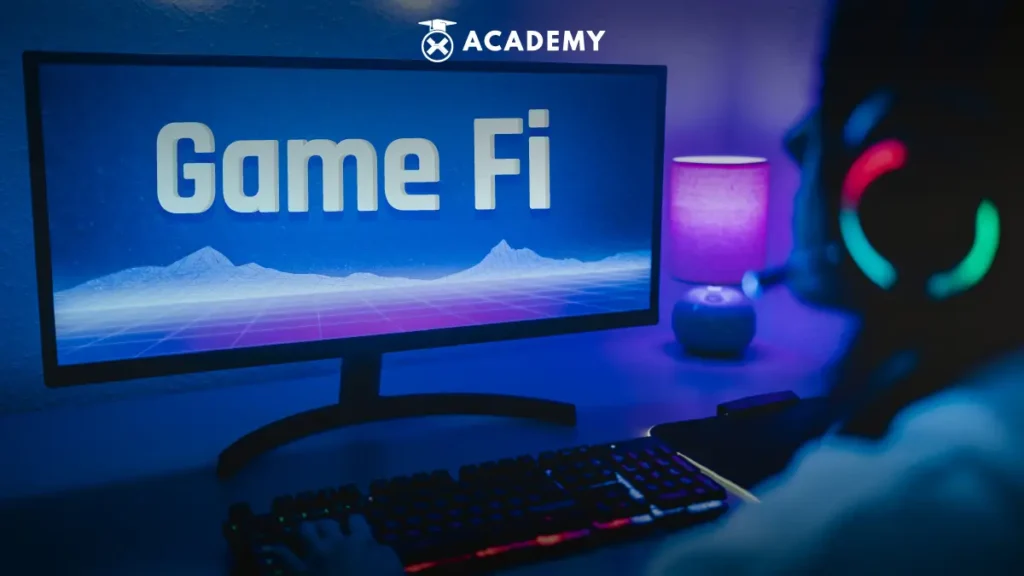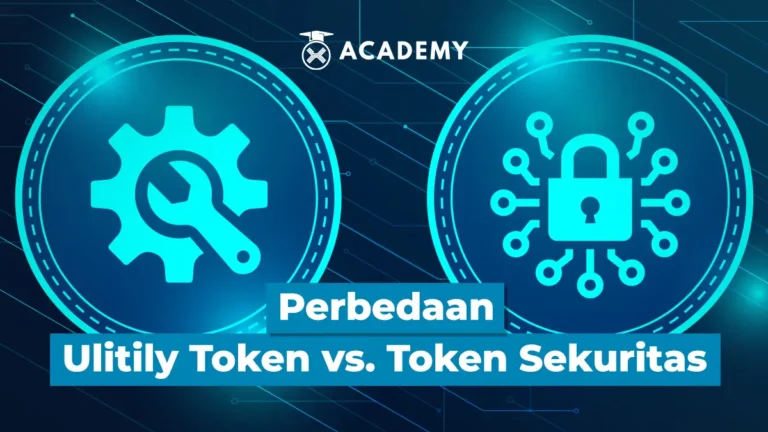One of the newest innovations in the online gaming industry that has attracted quite a lot of attention in recent times is GameFi. The GameFi phenomenon combines gaming and decentralized finance (DeFi) in the crypto realm. It creates a new ecosystem that allows players to participate in entertaining online games and generate real income.
This phenomenon marked a revolution in the gaming industry by introducing the play-to-earn concept, where players can earn crypto or digital assets through active participation in the game. The relationship between “gaming” and “DeFi” in GameFi can be seen from many aspects, including asset ownership.
In GameFi, in-game assets such as characters, weapons, or properties are NFT (Non-Fungible Token) tokens. This means players own these assets as digital tokens verified on the blockchain. DeFi also allows asset owners to monetize their holdings by generating income through staking and others, thereby creating opportunities to earn attractive passive income.
So, to understand what GameFi is, examples, how it works, the benefits of the technology, things you need to pay attention to when playing GameFi, GameFi activities other than games, and the future of GameFi, see the complete review below!
What is GameFi?
GameFi is an abbreviation for “Game Finance,” which refers to a genre in the crypto industry. This genre combines game elements with finance.
In the GameFi ecosystem, online games use blockchain technology and decentralized finance (DeFi) concepts to provide a more interactive gaming experience and allow players to earn income through various means. The origins of GameFi can be traced back to the development of blockchain technology and decentralized finance. As crypto assets such as Bitcoin and Ethereum become popular, developers combine these concepts with online gaming.
Blockchain technology allows digital assets used in games (characters, weapons, or items) to be unique and verifiable, creating the concept of NFTs in gaming.
GameFi is a concept that combines gaming and finance through decentralized applications (dApps) running on a distributed ledger network. This allows players to have legal ownership of various verified in-game items.
In GameFi, the play-to-earn concept is present for game lovers. In contrast to the traditional pay-to-play model, where players have to pay to access certain features or items in the game, play-to-earn flips the concept on its head. Players get economic incentives when playing and owning things in the GameFi environment. Completing missions, winning matches, and advancing to certain levels can earn players financial rewards. Moreover, players can trade assets held within GameFi outside the game via NFT markets or crypto exchanges.
Blockchain technology is known to have a critical role in GameFi. Blockchain technology’s primary roles in GameFi include unique ownership and asset verification. Furthermore, blockchain technology empowers the utilization of NFT assets across different games.
Blockchain also provides high security because transactions recorded are permanent and cannot be changed. This eliminates the risk of counterfeiting or manipulating digital assets. Not only that, blockchain also allows transparent recording and full transparency of rewards in the form of crypto tokens. Furthermore, blockchain technology enables integration with decentralized financial protocols so players can lend their assets, earn returns on their investments, or even earn passive income.
What are Some Examples of GameFi?

It is essential to know what examples of GameFi are because this will provide an understanding of how blockchain technology and DeFi concepts are applied in gaming. Check out these examples of games that you can play:
1. CryptoBlade
CryptoBlade is a web-based role-playing game that brings the nostalgia of traditional games, such as Skyrim or Dark Souls. In this game, players can fight monsters and complete attacks to obtain Skill tokens, which are the main assets in this game.
To maximize success in battle, players can create weapons that will give them a strategic advantage against opponents or enhance their character’s abilities and trade these items on the open market within the game ecosystem.
CryptoBlade’s gameplay uses four essential components: fire, earth, lightning, and water, allocated to characters, weapons, attributes, and enemies. Each piece has strengths and weaknesses that require players to combine and build effective strategies to overcome opponents.
To start an adventure on CryptoBlade, users need to invest an amount of around 0.2 BNB in creating playing and pay transaction fees associated with in-game activities.
2. Axie Infinity
Axie Infinity is a game that allows players to get digital creatures called Axies. Players can adopt, care for, and breed these Axies. Even more interesting, players can engage Axies in battles against other creatures to obtain prizes in the form of SLP tokens.
Axie Infinity has another token called AXS in addition to the SLP token. The concept of this game is similar to the Pokémon game but with a touch of blockchain technology.
3. Upland
Upland is an NFT metaverse that depicts properties in parallel worlds. Properties in Upland are linked to real-world property addresses.
In this game, players can become businesspeople and landowners, managing and developing virtual properties and capitalizing on the NFT metaverse value of those properties. The way to play is similar to Monopoly but with virtual properties linked to blockchain technology.
4. STEPN
Introducing a different concept in the GameFi world, StepN comes with an idea called move-to-earn, which has recently become a hot topic of conversation in the GameFi community.
As the name suggests, users can earn rewards while moving. The move-to-earn concept relates more to lifestyle than gaming, where users are rewarded when they perform physical activities, such as walking. Users on StepN earn Green Satoshi Tokens (GST), the game’s crypto token, when they walk or run.
Even though this concept sounds attractive and simple. Unfortunately, access to StepN requires quite a high cost. To get GST tokens, users must buy virtual shoes through the marketplace provided.
5. Era7
Game of Truth is the latest GameFi play-to-earn project to attract attention. This is a card trading game.
Era7 leverages NFT technology, turning in-game cards into tradable assets. Users have the opportunity to play in PvE or PvP mode by arranging and arranging the cards to create the most substantial deck. The cards in Era7 have NFT status, giving them actual value. Users can obtain high-value cards through matches, trading, or combining unique cards.
The game uses two crypto tokens, namely Era and GOT. Users can earn Era tokens through competitions, liquidity mining, or community incentives. They can also use them to make transactions in the Era7 game. Meanwhile, GOT tokens can be earned by purchasing them using Era tokens or via the play-to-earn model. GOT tokens are used to summon or synthesize cards in the game. Furthermore, according to data from DappRadar.com, Era7: Game of Truth has recorded significant growth recently.
Getting to Know How GameFi Works
GameFi’s popularity started with CryptoKitties, a blockchain-based game built on the Ethereum network. The smart contract technology introduced by Ethereum opened the door to innovations, including DeFi and GameFi. In developing the GameFi platform, smart contracts and other blockchains, such as Solana, Polkadot, and Polygon, were utilized.
As previously explained, GameFi operates with a play-to-earn concept, where players can earn various rewards, ranging from crypto assets to in-game items such as avatars, weapons, costumes, or virtual lands. In contrast to traditional games, where such assets have no value outside the game environment, assets earned in GameFi have real value and can be traded. This allows players to earn income through the GameFi platform.
In the GameFi ecosystem, NFTs also act as in-game assets. NFTs allow these assets to be traded on NFT marketplaces. Through blockchain technology, GameFi will enable players to own their digital assets, which can be monetized. In the context of the metaverse, some GameFi platforms allow players to generate income from their virtual land holdings.
All game data is known to be stored in a decentralized public blockchain network. This means asset ownership can be accessed and tracked by anyone. These assets are owned entirely by the players, not the game developer, as in the traditional model. This creates a transparent and empowering environment for players in the GameFi ecosystem.
Benefits of GameFi Technology

It is important to note that GameFi technology allows players to prove ownership of items in their games easily. This also eliminates doubts and ensures transparency in asset ownership.
Here are some of the benefits of GameFi technology that you need to know, including:
- In GameFi, there is no point of failure. This means players no longer risk losing track of their holdings when a gaming company experiences technical issues. Ownership data is also safe on the blockchain.
- Items obtained during gameplay using GameFi technology cannot be counterfeited, deleted, or destroyed. This is to ensure the integrity and authenticity of every item in the game ecosystem.
- The main crypto assets in the game can be sent and received without involving intermediaries, clearing, or custody. This is to speed up the transaction process and reduce related costs.
In addition, several GameFi games also include DeFi elements, such as staking, where players can lock specific crypto tokens to earn annual interest and other rewards. By utilizing this feature, players can optimize their crypto assets and earn additional profits that they can use to purchase in-game items or unlock new content.
Things to Pay Attention to when Playing GameFi
To be able to engage in play-to-earn games, users must carry out the following steps, namely:
- Create a Crypto Wallet: Users must create a crypto wallet to store their virtual assets and NFTs and make in-game transactions. The choice of a wallet depends on the blockchain on which the game is built. For example, MetaMask, an Ethereum-based wallet service, will be compatible with GameFi games created on the Ethereum network.
- Purchase Starter Items: Some GameFi games require in-app purchases to access characters, crypto tokens, and other upgrades.
- Making Deposits: Users need to make deposits by storing crypto assets in their wallets using certain crypto assets. These assets will later be used to purchase initial items and gain progress in the game.
For example, in Cryptoblade, users must download MetaMask, purchase the required crypto coins, and exchange them for the game’s native crypto asset, SKILL, to begin their adventure.
Three GameFi Activities Besides Gaming
Gamers don’t just spend time playing GameFi to increase their income or profit optimally. In general, there are three types of activities in GameFi that can increase gamers’ income, namely:
1. Buying and Selling Assets
Gamers can create assets such as houses, costumes, or weapons in the game. These assets can be sold to other gamers via the GameFi NFT marketplace.
2. Barter Assets
Apart from buying and selling transactions, players can also exchange assets according to the agreement between the players. Players trade rare items to boost performance.
3. Staking
As a blockchain-based application, several GameFi developers provide crypto asset staking options for gamers interested in becoming network validators. Asset values can increase through staking while generating passive income through digital assets. In this way, gamers can increase their profits through various economic strategies in the GameFi ecosystem.
The Future of GameFi
Knowing the future of GameFi is the key to understanding the changes that will occur in the gaming industry and decentralized financial technology.
The potential for GameFi itself is predicted to be very large, mainly because the gaming industry is expected to reach a value of around $314,400,000,000 in 2026, as quoted from Coinvestasi.com. Some leading video game companies, such as Sony, Tencent, Nintendo, and Microsoft, have managed to generate gaming revenues of over $10,000,000,000 each.
If these gaming companies decide to involve themselves in the GameFi world, this trend could attract tremendous attention from the public and result in widespread adoption. Integrating these established games into GameFi can change the gaming industry landscape and present significant financial opportunities for players.
Conclusion
In conclusion, GameFi played a crucial role in transforming the online gaming world by introducing the play-to-earn concept, which provides an entertaining gaming experience and offers players unique financial opportunities. In the GameFi ecosystem, online games use blockchain technology and decentralized finance (DeFi) concepts to provide a more interactive gaming experience and allow players to earn income through various means.
By providing financial opportunities that change the way people view gaming, GameFi has created a dynamic online gaming ecosystem that has the potential to change the way people view and interact with the world of gaming. It is a game and an opportunity to develop financial sustainability and creativity in the digital world.
So, now you understand what GameFi is, how it works, and the future of GameFi. You can also read other interesting articles, such as a list of the best Android NFT games and gala games on INDODAX Academy.
INDODAX Academy is the best platform, allowing anyone to deepen their knowledge of crypto assets and blockchain technology. Later, after gaining a deep understanding of the crypto asset market and blockchain technology with INDODAX Academy, you can start the next step, namely investing in crypto assets through the best and most trusted crypto platform, INDODAX.
Let’s increase your understanding of the world of crypto assets with INDODAX Academy and invest in crypto only on INDODAX!








